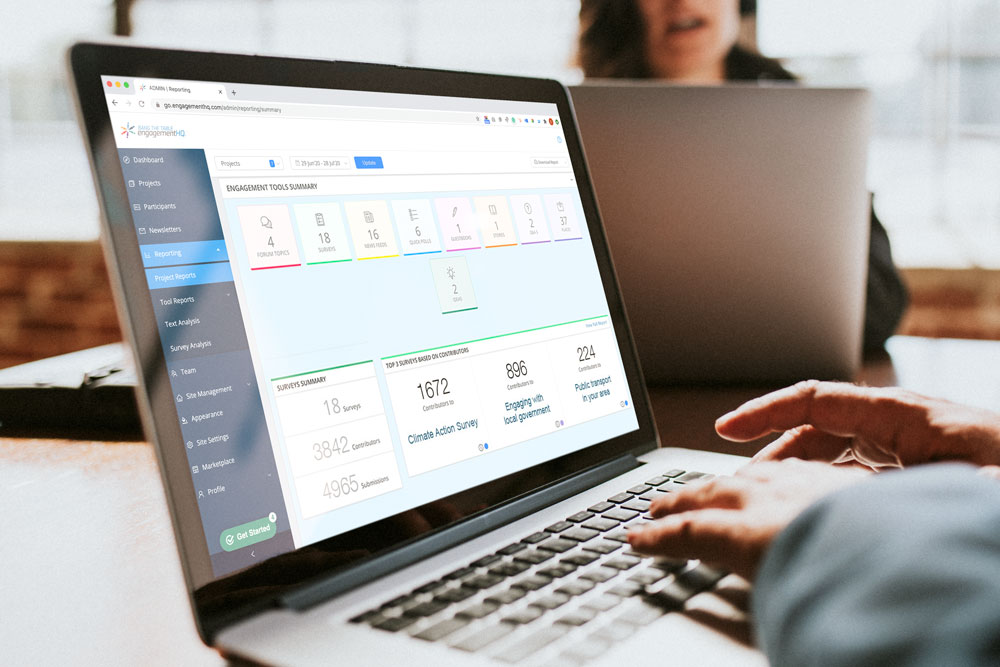
This guest post is by Stéphanie Beauregard, Practice Lead with Bang the Table.
You have to report the results of your consultation with your community, with decision-makers and, perhaps, even some of your expert teams.  How do you ensure that the outcome of your consultation is well-documented?
How do you ensure that the outcome of your consultation is well-documented?
Step 1: Build Your Project Effectively
By clearly identifying your project’s objectives and asking engaging questions, feedback will be more relevant and useful. Moreover, it’s important to ask questions strategically from the beginning.
Think carefully about your questions: if you ask a very generic question, chances are that you will get less useful answers. Generic questions also open the door to complaints. People like to complain! With a specific question, there may be fewer answers, but they will be of higher quality. For instance, instead of asking the question, “What do you think?”, ask instead, “What are your top three priorities?”
Step 2: Understanding Your Participants
Google Analytics doesn’t allow for accurate measurement of commitment to a project. For example, the time a person spends on a web page does not tell you what they are doing during the visit. So, we developed a system to provide useful statistics: Aware – Informed – Engaged.
This system is based on the three phases of engagement:
- Aware: Participants that are aware that the project exists. This is the result of your promotional activities.
- Informed: Participants that are well informed about a subject and take time to think before participating.
- Engaged: And, finally, participants who provide feedback and contributions to a consultation.
EngagementHQ not only provides the opportunity to measure engagement but also has the tools to create a project page that’s designed to encourage participants to move beyond just awareness.
Step 3: Contribution Analysis
A system that analyzes all comments for us and gives us access to the results without having to read the contributions made on a project would be ideal. However, in our opinion, there is a balance to be found. For instance, a machine may never understand that a Chihuahua, a Great Dane, and a Golden Retriever are all dogs. But, a machine can determine if a comment has a positive or negative sentiment. Identifying the level of analysis needed is also important.
EngagementHQ can help through its text analysis tool that allows for quick and efficient labeling of all comments received on a project. A few features are below:
- A drop-down list of labels is available to quickly assign them to comment.
- Can search for a keyword and assign it as a label to all comments that contain that word.
- Get a complete report in Excel format that helps you create logic in all the comments submitted on a site.
The latest innovation is the use of artificial intelligence for sentiment analysis. The tool enables a reliable picture of the sentiment expressed in consultation through the comments and contributions. It is possible to confirm each of the feelings yourself, so the AI can be double-checked by humans!
Step 4: What about surveys?
Because the survey remains the most widely used tool on EngagementHQ and the data collected has a specific format, the Surveys and Forms tool has its own analysis tool. Graphs and easy-to-read graphics are produced for each question. You can also apply these features:
- Apply a filter, for example: How did people living in rural areas answer the questions?
- Make a comparison, such as: How do you compare the survey responses between people living in rural areas and those in urban areas?
- Do a cross-analysis by applying a third variable to the above question, such as household income.
Customize these reports in pdf format directly on EngagementHQ to obtain a result that can be quickly shared with your community.
Step 5: Closing the conversation loop
Whether it’s a quick “What we heard” report or a fully detailed report, participants want to be aware of it and consult it. Reports can be prominently displayed on your site, and posted creatively:
- Changing an introductory message: Instead of inviting your community to participate, if your project is finished, thank them and point them to your report.
- Posting a news article: The News Feed is a page that allows for posted articles to keep a community up to date.
- Sending an email to participants in your database: This is the advantage of asking your participants to create an account. You can keep them informed about the progress of any project.
To learn more, see examples, and visit the administrator interface, register for the webinar on August 20 at 1:00 p ET.
